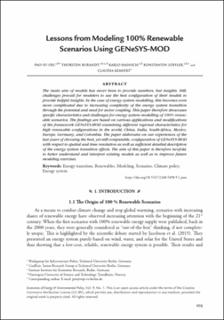| dc.contributor.author | Oei, Pao-Yu | |
| dc.contributor.author | Burandt, Thorsten | |
| dc.contributor.author | Hainsch, Karlo | |
| dc.contributor.author | Löffler, Konstantin | |
| dc.contributor.author | Kemfert, Claudia | |
| dc.date.accessioned | 2020-04-03T09:50:30Z | |
| dc.date.available | 2020-04-03T09:50:30Z | |
| dc.date.created | 2020-04-01T13:42:28Z | |
| dc.date.issued | 2020 | |
| dc.identifier.citation | Economics of Energy & Environmental Policy. 2020, 9 (1), 103-117. | en_US |
| dc.identifier.issn | 2160-5882 | |
| dc.identifier.uri | https://hdl.handle.net/11250/2650264 | |
| dc.description.abstract | The main aim of models has never been to provide numbers, but insights. Still, challenges prevail for modelers to use the best configuration of their models to provide helpful insights. In the case of energy system modelling, this becomes even more complicated due to increasing complexity of the energy system transition through the potential and need for sector coupling. This paper therefore showcases specific characteristics and challenges for energy system modelling of 100% renewable scenarios. The findings are based on various applications and modifications of the framework GENeSYS-MOD examining different regional characteristics for high renewable configurations in the world, China, India, South-Africa, Mexico, Europe, Germany, and Colombia. The paper elaborates on our experiences of the last years of choosing the best, yet still computable, configuration of GENeSYS-MOD with respect to spatial and time resolution as well as sufficient detailed description of the energy system transition effects. The aim of this paper is therefore twofold, to better understand | en_US |
| dc.language.iso | eng | en_US |
| dc.publisher | IAEE, International Association for Energy Economics | en_US |
| dc.relation.uri | http://www.iaee.org/eeep/article/306 | |
| dc.rights | Navngivelse 4.0 Internasjonal | * |
| dc.rights.uri | http://creativecommons.org/licenses/by/4.0/deed.no | * |
| dc.title | Lessons from Modeling 100% Renewable Scenarios Using GENeSYS-MOD | en_US |
| dc.type | Peer reviewed | en_US |
| dc.type | Journal article | en_US |
| dc.description.version | publishedVersion | en_US |
| dc.source.pagenumber | 103-117 | en_US |
| dc.source.volume | 9 | en_US |
| dc.source.journal | Economics of Energy & Environmental Policy | en_US |
| dc.source.issue | 1 | en_US |
| dc.identifier.doi | 10.5547/2160-5890.9.1.poei | |
| dc.identifier.cristin | 1804784 | |
| dc.description.localcode | Open Access CC-BY | en_US |
| cristin.ispublished | true | |
| cristin.fulltext | original | |
| cristin.qualitycode | 1 | |

